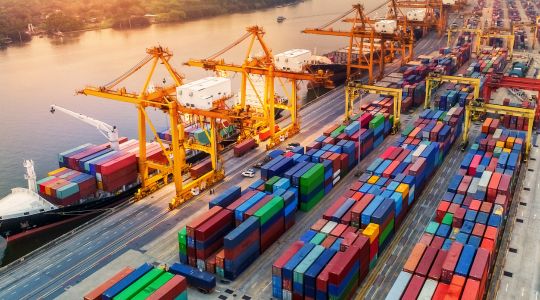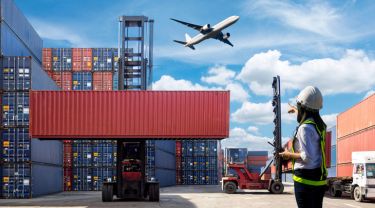The United States imposed 25% tariffs on Canadian steel and aluminum imports beginning March 12, 2025, under an executive order by U.S. President Donald Trump. The measure was taken under Section 232 of the Trade Expansion Act of 1962, which gives the president considerable policy discretion. Canada responded with reciprocal measures against U.S. steel, aluminum and other products.
Similar to the tariffs the first Trump administration placed on steel and aluminum from Canada and other countries in 2018, the new tariffs are based on national security grounds. There are more troubling elements to the tariffs—and greater challenges for Canadian companies—this time around.
On June 4, 2025, the Trump administration doubled the steel and aluminum tariffs to 50%.
Export Development Canada (EDC) understands the detrimental impact of these new tariffs on Canadian producers of steel and aluminum. Companies are experiencing contract cancellations and the rapid, unanticipated changes have injected tremendous uncertainty into the business environment. We’re committed to providing Canadian exporters with the knowledge and support needed to navigate these challenges and seize new global opportunities.

This article explains the steel and aluminum tariffs, discusses the potential impact on your supply chains and outlines actionable strategies you can use to help mitigate the effects of these tariffs.
Expanded tariffs—and challenges—for Canada’s steel and aluminum industries
Canadian steel and aluminum exporters have faced escalating economic threats from the second Trump administration. The measures announced in 2025 are vastly wider in scope than those imposed in the first Trump administration.
“These tariffs are hugely disruptive,” says David Weiner, regional vice-president for EDC in the U.S.
There are key differences in the 2025 tariffs compared with the 2018 measures:
- The tax on aluminum first increased from 10% to 25%, then doubled to 50%.
- The “alternative arrangements” and exclusions allowed in 2018 have been eliminated.
- The tariffs apply to “downstream products” made of steel and aluminum.
- The steel and aluminum tariffs could be added to country tariffs imposed on all imports, known as “stacking.”
Jean-Simon Bleau, an EDC senior relationship manager who works with aluminum and steel companies in Quebec City, Lac St-Jean and the Cote Nord region, says that any new tax measures bring uncertainty, “but right now, it’s off the charts.”
Firms experiencing a slowdown in their business are conducting cost-optimization exercises while looking to EDC for help in areas such as managing cash flow, he says. “They are focusing on surviving this storm right now.”
Amesika Baëta, EDC’s regional director for mid-market businesses in the western Greater Toronto Area, says companies are looking for help in finding new markets and using EDC credit insurance to ensure they get paid. “The geopolitical pressures that we’re facing today are very different than what we’ve seen in a very long time,” she says.
Strategies for dealing with the tariffs
Canadian companies can adopt several strategies to navigate the tariffs:
- Consider market diversification: Explore alternative (or additional) markets to reduce dependence on the U.S. and diversify your supply chains. Small- and medium-sized enterprises (SMEs), for example, firms with steel and aluminum product, may be eligible for funding under the Trade Commissioner Service’s (TCS) CanExport SMEs program, which supports activities that develop new export markets.

- Programs such as the Scientific Research & Experimental Development tax incentives, the Ontario Made Manufacturing Investment Tax Credit and the Clean Technology Investment Tax Credit can help ease financial constraints for companies.
- Engage with industry associations, like the Canadian Steel Producers Association and Aluminum Association of Canada for guidance and support.
- Investigate setting up a U.S. Customs and Border Protection Automated Clearinghouse (ACH) account to streamline tariff payments.
- Consult with customs brokers, as well as trade law experts and firms specializing in international tariffs and trade regulations.
Mike Brownhill, a commercial account director at EDC who covers advanced manufacturing with a focus on the automotive sector, says firms are devoting resources to tariff issues. This includes looking at Harmonized System (HS) classifications and codes while seeking workarounds and ways they might find tariff exemptions.
“Companies are realizing the importance of consulting their customs brokers and are now noting the need to pay increased attention to how things are coded and billed, given that one subtlety in the tariff codes could have large impacts on fees payable,” he points out.
Navigating what’s ahead
Weiner predicts that volatility will be the order of the day for Canada’s steel and aluminum exporters. “You can’t take anything for granted; countries are going to be applying and retaliating against tariffs everywhere—all the time,” he says, adding that it’s important to be flexible and look for opportunities. “I think companies can adapt to any scenario, like it or not, but it needs to be predictable. The hardest thing in this current environment is that nothing’s predictable.”
But he expects the tariff crisis “isn’t going to last forever,” but the relationships that Canadian exporters have spent decades building will.
“Companies are in survival mode and they’re going to do whatever they have to,” Weiner explains. “But I believe in the long run, things are going to settle down and they’ll be back to more or less the way they were before. So, be kind to your supplier; be kind to your buyer; try and work out solutions because everybody’s in this together.”
With the $5 billion in additional capacity allocated through our Trade Impact Program, EDC is ready to meet heightened demand for financing and insurance solutions, he adds. “And we’ll continue to adjust our support to meet changing needs.”
How EDC can help
EDC’s tariff-mitigation checklist for exporters outlines actions that Canadian companies can take to navigate uncertainties due to the tariffs.
Our Trade Impact Program will facilitate an additional $5 billion over two years in support under various programs to help eligible companies deal with economic challenges:
- Export confidently: EDC trade credit insurance protects against losses in the event your foreign buyer doesn’t pay.
- Manage currency fluctuations: We offer solutions that mitigate the risks associated with foreign exchange fluctuations by stabilizing your costs and protecting your profit margins from adverse currency movements.
- Access more working capital: EDC guarantees share a portion of your financial institution’s risk, enabling you to access more financing for managing cash flow challenges and growing your operations.
- Enable global expansion: EDC’s financing solutions enable you to increase your capacity for trade, expand your footprint in different markets, or acquire a foreign company.
Be sure to check out EDC’s new U.S. market intelligence hub for the latest information and insights to navigate Canada’s largest export market. To connect with an export advisor, register for our Export Help Hub.
Key facts: Canada-U.S. steel and aluminum trade
Canada’s exports of iron and steel to the U.S.: In 2024, Canada exported $12.1 billion in iron and steel (which includes iron and steel mills and ferro-alloy manufacturing, as well as steel product manufacturing from purchased steel). More than 91% of that went to the U.S.
Source: Trade Data Online/Statistics Canada
U.S. iron and steel import reliance: In 2024, 13% of the U.S.’s consumption of iron and steel came from imports. Canada took 20% of the U.S.’s 2024 iron and steel imports, making Canada the country’s No. 1 import source.
Source: U.S. Geological Survey (USGS) Mineral Commodity Summaries 2025 (page 94-95); USA Trade Online/U.S. Census Bureau
U.S. iron and steel scrap import reliance: From 2020-2023, Canada, on average, took 71% of the U.S.’s scrap imports, making Canada the country’s No.1 import source.
Source: USGS Mineral Commodity Summaries 2025 (pages 96-97)
Canada’s iron and steel imports from the U.S.: The U.S. is also Canada’s biggest source of iron and steel. It sent Canada almost 45% of the $15.5 billion worth of iron and steel imported in 2024.
Source: Trade Data Online/Statistics Canada
Canada’s exports of aluminum to the U.S.: In 2024, Canada exported $14.1 billion in aluminum (which includes alumina and aluminum production and processing) and 94% of that went to the U.S.
Source: Trade Data Online/Statistics Canada
U.S. aluminum import reliance: In 2024, 47% of the U.S.’s consumption of aluminum came from imports. Canada took 50% of the U.S.’s 2024 aluminum imports, making Canada the country’s No. 1 import source.
Sources: USGS Mineral Commodity Summaries 2025 (pages 32-33); USA Trade Online/U.S. Census Bureau
Canada’s aluminum imports from the U.S.: The U.S. is the biggest source of Canada’s aluminum imports. It sent Canada 32% of the $7.7 billion in aluminum imported in 2024.
Source: Trade Data Online/Statistics Canada
Where in the world do Canada’s steel and aluminum exports go?
Diversifying Canada’s exports has become imperative given the U.S. trade threats involving Canadian products. For Canadian steel and aluminum producers, the U.S. has been an outsized customer, buying a vast proportion of Canada’s exports compared with other countries:
Top 10 destination markets for Canada’s exports of iron and steel |
|
Country |
Value in thousands of Canadian dollars |
United States |
10,986,618 |
Mexico |
520,317 |
Netherlands |
162,398 |
China |
61,784 |
Brazil |
33,255 |
Australia |
31,008 |
India |
28,203 |
Germany |
27,084 |
Bangladesh |
24,756 |
South Korea |
24,342 |
Others |
168,524 |
Total all countries |
12,068,289 |
Source: Trade Data Online/Statistics Canada.
|
|
Top 10 destination markets for Canada’s exports of aluminum |
|
Country |
Value in thousands of Canadian dollars |
United States |
13,237,193 |
Mexico |
327,754 |
Netherlands |
211,672 |
Italy (incl. Vatican) |
109,410 |
Malaysia |
61,844 |
India |
17,530 |
Poland |
11,979 |
United Kingdom |
11,429 |
Germany |
9,329 |
France (incl Monaco, French Antilles) |
6,679 |
Others |
53,536 |
Total all countries |
14,058,354 |
Source: Trade Data Online/Statistics Canada.
|
|
The history of steel and aluminum tariffs in Canada
In 2018, the U.S. administration imposed a 25% tariff on steel and 10% tariff on aluminum on the basis of national security under Section 232 of the Trade Expansion Act of 1962, a law that had rarely been used before that.
The tariffs took effect on March 23, 2018, for a select group of countries, including Russia, China, Japan and India. Countries such as Canada were given temporary exemptions, but the U.S. announced an end to those tariff exemptions effective June 1, 2018. In response, Canada imposed retaliatory tariffs of 25% on imports of U.S. steel and 10% on imports of U.S. aluminum on July 1, 2018. Both governments lifted their respective tariffs on May 20, 2019.
A 2019 Statistics Canada report on the impact of the tariffs shows:
- The value of Canadian steel exports to the U.S., which had been on an upward trend prior to the introduction of the tariffs, fell to its lowest level in almost 10 years by the time they were removed.
- Canada’s aluminum exports to the U.S. were 19% lower during the year the tariffs were in place, compared with the year before.
These weren’t the first such tariffs introduced by the U.S. In 2002, President George W. Bush imposed tariffs of up to 30% on steel products from certain countries. As NAFTA (North American Free Trade Agreement) partners, Canada and Mexico were exempt, as were some developing countries. The tariffs were repealed after 18 months under a World Trade Organization ruling.
Canada imposed a 25% tariff on steel and aluminum products from China effective Oct. 22, 2024. The measure is intended to protect the Canadian steel and aluminum sectors against China’s unfair trade policies.
Navigate uncertainty with support from EDC
For 80 years, EDC has been helping Canadian companies expand on the global stage. Through economic upturns and downturns, whether under protectionist policies or free trade, we’ve stood by your side. From market insights to financial tools, we’re here to help you on your export journey. Reach out to get started.
New to EDC? Take a quick assessment to see how we can support your business.
Already an EDC customer? Contact your EDC relationship manager or call us at 1-800-229-0575.





